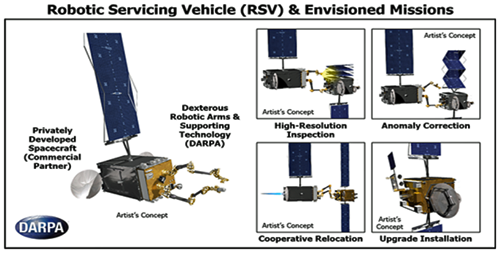
Space satellites are about to get something they’ve never had before: curbside service. Such fix-it trips to space have long been considered too expensive and too difficult. Now a team led by Space Systems Loral, with support from Draper, seeks to do just that under DARPA’s Robotic Servicing of Geosynchronous Satellites (RSGS) program.

Until recently, the accepted practice among governments and commercial entities was that it was too expensive and too difficult to service a satellite on orbit. Anywhere from 12 to 36 satellites go into geosynchronous (GEO) orbit every year, and no one expects to fix them if something breaks.
With RSGS, DARPA plans to develop a robotic module, including hardware and software, and provide technical expertise and a government-funded launch. SSL would provide a spacecraft and would be responsible for integrating the module onto it to create a robotic servicing vehicle (RSV) and the RSV onto the launch vehicle, as well as providing a mission operations center and staff.

Draper, in support of RSGS and in collaboration with SSL, will provide technologies that aim to enable cooperative inspection and servicing of satellites in GEO, which is more than 20,000 miles above the Earth, and demonstrate those technologies on orbit.
For the mission, Draper is supporting SSL in using a robotic servicing platform equipped with a camera, robotic arm, fuel reserve and capabilities in GN&C rendezvous and proximity operations. When launched, the RSV promises to have the capability to perform multiple servicing missions for both planned and urgent customer needs, including: high-resolution inspection; refueling; correction of mechanical anomalies; assistance with relocation and other orbital maneuvers; and installation of attachable payloads, enabling upgrades to existing assets. SSL anticipates being able to market these services as a commercial business and is already in discussion with several key customers.
Draper is also supporting SSL on NASA’s Restore-L mission to service satellites in Low Earth Orbit. Draper will assist SSL in utilizing a robotic servicing platform equipped with a camera, robotic arm, fuel reserve and capabilities in GN&C rendezvous and proximity operations. Beyond the refueling demonstration, the Restore-L project will test crosscutting technologies that are fundamental to NASA’s future exploration and science architectures.
Draper’s contract work for RSGS will be performed in Huntsville, Alabama; Cambridge, Massachusetts; and Houston, Texas.
Seamus Tuohy, director of Space Systems at Draper, noted that this is a new era of advanced, cost-effective robotic capabilities in space, well-timed as the commercialization of space takes off. At Draper, the company occupies a special position within the space ecosystem that gives the firm deep expertise in what’s required — and how to deliver — commercial technologies that will perform in space.

